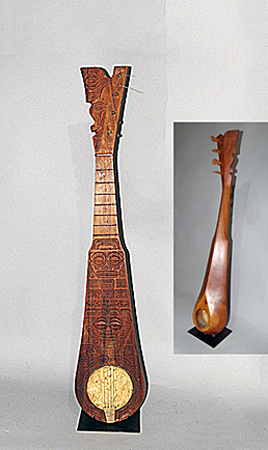
Owner: HWMC
Catalog#: 2OC-CHLT-01
Chordophones - Lutes
Marquesas Islands ʻUkarere
Marquesas Islands (French Polynesia)
Marquesan People
Wood, hide, metal, nylon strings
ca. Mid 20th century
Length: 34 in; Width: 6.75 in; Depth: 2.75 in
Chordophones – Lutes
This mid 20th century Marquesas Islands ʻukarere, is a short-necked fretted lute with four wooden frontal friction tuners and nylon strings. A variety of tunings are employed by Marquesan players, with a popular one being: c’, f’, a’, d’. The ʻukarere is also native to other regions of Polynesia and is a variant of the older Hawaiian ukulele, however noted by a higher and thinner sound when played. Unlike the Hawaiian ukulele, it is carved from a solid, single block of mi’o (thespesia populnea) or tou (cordia subcordata) wood, with a hallow body, which is unlike the Tahitian ukulele that does not have a hollow soundbox. A wide conical hole is bored through the middle of this ‘ukarere that is covered with a goatskin membrane, much like a banjo drum. The hide is kept stretched by a metal strapping (ring) set around the perimeter of the opening on top. In the back of the body, a second circular hole serves as the sound hole. The four nylon strings are secured to a tailpiece at the bottom, made of another type of wood. There are seven wooden frets in the neck and at the top is a bridge. A movable bridge across the resonating hide for the strings to rest on is missing. The relief carving seen on the top surface of this instrument draws upon traditional Polynesian iconography and notably from the region of the Marquesas Islands.
The ʻukarere is a locally made instrument used to accompany pan-Pacific popular songs (impromptu social entertainment). Along with the guitar, the ʻukarere also accompanies choreographed ‘aparima dances from Tahiti as well as tamure partner dances in ‘ori Tahiti (Tahitian dance) style.
Reference: Music in the Southern Marquesas Islands. Author: Jane Moulin. Publisher: Occasional Papers in Pacific Ethnomusicology No 3; University of Auckland Department of Anthropology.
